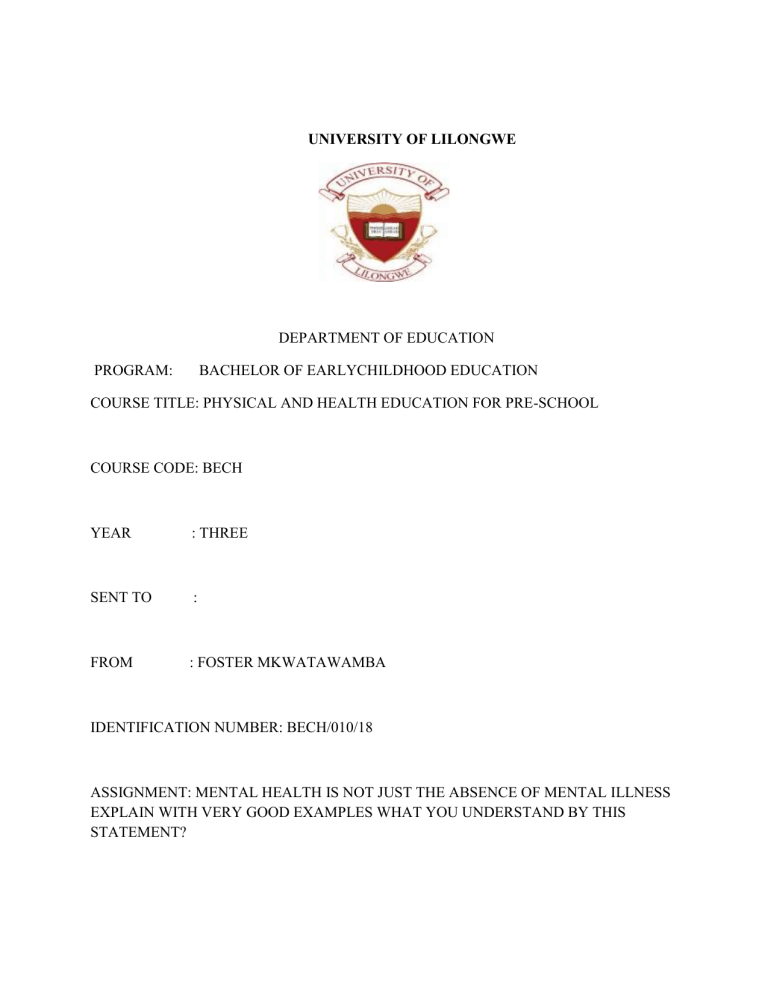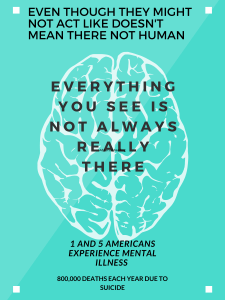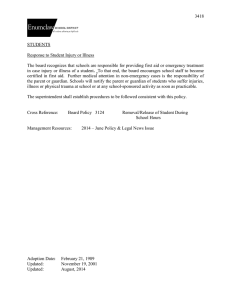
UNIVERSITY OF LILONGWE DEPARTMENT OF EDUCATION PROGRAM: BACHELOR OF EARLYCHILDHOOD EDUCATION COURSE TITLE: PHYSICAL AND HEALTH EDUCATION FOR PRE-SCHOOL COURSE CODE: BECH YEAR : THREE SENT TO : FROM : FOSTER MKWATAWAMBA IDENTIFICATION NUMBER: BECH/010/18 ASSIGNMENT: MENTAL HEALTH IS NOT JUST THE ABSENCE OF MENTAL ILLNESS EXPLAIN WITH VERY GOOD EXAMPLES WHAT YOU UNDERSTAND BY THIS STATEMENT? Mental health. “Mental health is a state of well-being in which an individual realizes his or her own abilities, can cope with the normal stresses of life, can work productively, and is able to make a contribution to his or her community.” The WHO stress that mental health is “more than just the absence of mental disorders or disabilities.” Peak mental health is about not only avoiding active conditions but also looking after ongoing wellness and happiness. There are factors that contribute to mental health apart from mental illness. For example biological factor stressed that the NIMH suggest that genetic family history can increase the likelihood of mental health conditions, as certain genes and gene variants put a person at higher risk. However, many other factors contribute to the development of these disorders. Having a gene with links to a mental health disorder, such as depression or schizophrenia, does not guarantee that a condition will develop. Likewise, people without related genes or a family history of mental illness can still have mental health issues. Mental health conditions such as stress, depression, and anxiety may develop due to underlying, life-changing physical health problems, such as cancer, diabetes, and chronic pain. Mental health is not just the absence of mental disorder. Because it is defined as a state of wellbeing in which every individual realizes his or her own potential, can cope with the normal stresses of life, can work productively and fruitfully, and is able to make a contribution to her or his community. To further understand why mental health is not just the absence of mental illness, we can think of understanding the root causes of mental health disorders. To understand it better, we can use critical analytical stages. At the first level of analysis, the root cause of mental illness is an amalgamation of heredity, biology, environmental stressors, and psychological trauma. To begin with amalgamation of heredity. This discusses that some mental illnesses comes from parents our ancestors. They posse some characteristics which we cope from them and if they had some diseases they transfer them to us. The notions of specific genes being responsible for illness have been supplanted by those of genetic complexity, where various genes operate in concert with non-genetic factors to affect mental illness. That is, health-relevant biology and mental health impact each other in a complex interplay, which is inherently social. Apart from hereditary information, some researchers have found out that some mental illnesses are caused by social isolation from friends. For example, one study, of many, found that social isolation leads to increased risk of coronary heart disease. Since low levels of social integration are related to higher levels of C-reactive protein, a marker of inflammation related to coronary heart disease, social integration is posited to be a biological link between social isolation and coronary heart disease. Moreover, social support affects physical perception. In a landmark study, researchers demonstrated that people accompanied by a supportive friend or those who imagined a supportive friend, estimated a hill to be less steep when compared to people who were alone. Mental health, like physical health, is more than the sum of functioning or malfunctioning parts. At the second level of analysis, the complex bio-social interplay scaffolding mental illness points to the fundamentally chemical underpinnings of human thinking and emotion. With recent advances in neuroscience like Clarity, we are now able to make the brain optically transparent, without having to section or reconstruct it, in order to examine the neuronal networks, subcellular structures, and more. In short, we can examine mental illness from a biological perspective. The depth and complexity of the bio-social root of mental illness, however, paints a more nuanced picture than discussed thus far. With such pioneering work, there is an increasingly popular assumption that the brain is the most important level at which to analyze human behavior. In this vein, mental illness perpetuates itself by virtue of the fact that people often consider it to be biologically determined. In turn, a ‘trait-like’ view of mental illness establishes a status quo of mental health stigma by reducing empathy. At the third level of analysis, the obsession with seeing mental health in terms of mental illness reveals the fallible assumption that mental health is simply the absence of mental disorder. However, the problematic landscape of mental health draws on a far wider set of working assumptions. That is, mental health, like physical health, is more than the sum of the functioning or malfunctioning parts. It is an overall well-being that must be considered in light of unique differences between physical health, cognition, and emotions, which can be lost in a solely global evaluation. But looking at the reasons why do we as a society take time to solving mental illness, which should have been targeted long ago, far more than we consider improving mental health? In part, because when we think of mental health, we think of raising the mean positive mental health of a population, more than closing the implementation gap between prevention, promotion, and treatment. Cumulatively, social environments are the lubricating oil to biological predispositions, which influence mental health, such that mental health and physical health should be considered holistically. In this vein, national mental health policies should not be solely concerned with mental disorders, to the detriment of mental health promotion. It is worth considering how mental health issues can be targeted using proactive behavioral programs. To achieve this, it is pivotal to involve all relevant government sectors such as education, labor, justice, and welfare sectors. In a diverse range of existing players, many nonprofits’, educational institutions’, and research groups’ efforts contribute to the solution landscape of mental health promotion. In Ireland, for example, schools have mental health promotional activities such as breathing exercises and anger management programs. Nonprofits around the world are increasingly seeing the value of community development programmers and capacity building. From the descriptions above we are now able to conclude that mental health caters a broad area not just the absence of mental illness. This assignment has discussed the root causes of mental health such as hereditary factors, the act of living alone, biology, environmental stressors, and psychological trauma. References Heffner, K. et al. (2011). Social isolation, C-reactive protein, and coronary heart disease mortality among community-dwelling adults. Social Science & Medicine, 72(9), 1482-1488. doi: 10.1016/j.socscimed.2011.03.016 Lozano, R. et al. (2012). Global and regional mortality from 235 causes of death for 20 age groups in 1990 and 2010: a systematic analysis for the Global Burden of Disease Study 2010. The Lancet, 380(9859), 2095-2128. doi: 10.1016/s0140-6736(12)61728-0 Naomi, V.( July 16, 2018) Mental Health is Not Just the Absence of Mental Illness Schnall, S.,et al. (2008). Social support and the perception of geographical slant. Journal of Experimental Social Psychology, 44(5), 1246-1255. doi: 10.1016/j.jesp.2008.04.011 World health Organization (Jan 24, 2011) facts about mental health



